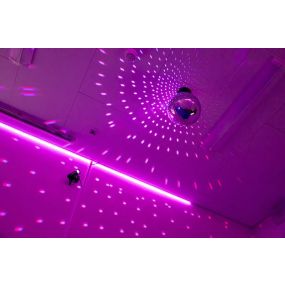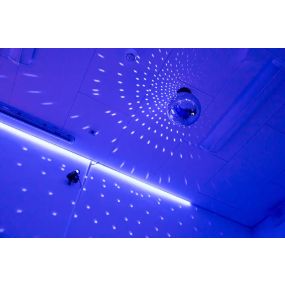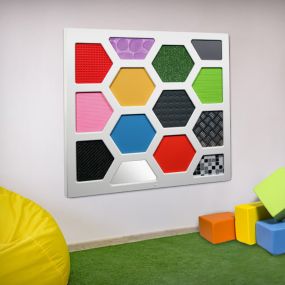We use cookies to make your experience better. Learn more
Lakeview Hospital Multi-Sensory Room

The newly completed sensory room at Lakeview Hospital offers a serene haven for patients seeking respite. Soft ambient lighting, soothing sounds, and gentle aromas create a tranquil atmosphere. Calming textures and comfortable seating provide a safe space for relaxation and sensory stimulation. It promotes healing and enhances the overall well-being of patients. This is the third sensory room completed for the Western Health & Social Care Trust.
In the realm of healthcare, the pursuit of holistic healing has led to innovative approaches aimed at addressing the physical, emotional, and psychological well-being of patients. One such innovation that has gained prominence in recent years is the concept of multi-sensory rooms in hospitals. These rooms are carefully designed spaces that engage patients' senses through a variety of stimuli, fostering an environment that promotes relaxation, stress reduction, and overall healing. In this blog, we will explore the importance of multi-sensory rooms in hospitals, shedding light on their numerous benefits and their role in improving the patient experience.
Creating a Soothing Oasis - Hospitals are often associated with sterile and anxiety-inducing environments. The harsh fluorescent lighting, the constant beeping of machines, and the absence of natural elements can exacerbate the stress and anxiety experienced by patients. Multi-sensory rooms, on the other hand, offer a welcome departure from this clinical atmosphere. These rooms are designed to create a soothing oasis within the hospital, providing patients with a sense of calm and comfort.
Visual Stimulation - One of the key features of multi-sensory rooms is the use of visual stimulation. Soft, ambient lighting, soothing colors, and visually pleasing elements like projected images or calming artwork can have a profound impact on a patient's mental state. These visual stimuli help reduce anxiety and create a more pleasant environment for both patients and their families.
Auditory Therapy - Sound plays a significant role in our emotional well-being. In multi-sensory rooms, carefully curated sounds such as gentle music, nature sounds, or even white noise machines can be used to create a serene auditory experience. This can help mask the often disconcerting noises of a hospital and promote relaxation.
Tactile Sensations - Another crucial aspect of multi-sensory rooms is the incorporation of tactile sensations. Soft fabrics, comfortable seating, and tactile surfaces provide patients with a sense of physical comfort and security. For individuals who may be bedridden or in pain, these tactile elements can offer much-needed relief.
Aromatherapy - The sense of smell is a powerful tool for evoking emotions and memories. Many multi-sensory rooms utilize aromatherapy to create a pleasant olfactory experience for patients. Scents like lavender, chamomile, and eucalyptus are known for their calming properties and can help reduce stress and anxiety.
Therapeutic Benefits
Multi-sensory rooms are not just about creating a pleasant environment; they also offer therapeutic benefits that can aid in the healing process. These benefits include:
Stress Reduction: The soothing atmosphere of multi-sensory rooms helps lower stress levels, which can have a positive impact on recovery and overall health.
Pain Management: Engaging the senses in a therapeutic way can distract patients from pain and discomfort, reducing the need for pain medications in some cases.
Improved Sleep: Many patients in hospitals struggle to get quality sleep due to the constant noise and disruptions. Multi-sensory rooms can provide a tranquil space conducive to restful sleep.
Enhanced Emotional Well-being: Patients dealing with anxiety, depression, or other emotional challenges can find solace and emotional support in these rooms.
Pediatric Patients - Multi-sensory rooms are especially beneficial for pediatric patients. Children can find hospital environments frightening and unfamiliar, which can exacerbate their stress levels. Multi-sensory rooms offer a child-friendly space where young patients can play, explore, and relax. These rooms can also be customized with age-appropriate sensory elements to cater to the specific needs and preferences of children.
Cognitive Benefits - Multi-sensory rooms have also shown promise in aiding patients with cognitive impairments, such as dementia or Alzheimer's disease. The carefully chosen sensory stimuli can help stimulate memory and cognition while reducing agitation and restlessness. This can improve the quality of life for patients with these conditions.
Caregiver Support - Multi-sensory rooms are not only for patients but also for their caregivers. The stress and emotional burden on family members can be immense when a loved one is in the hospital. These rooms provide a respite for caregivers, allowing them to relax and recharge while their loved one benefits from the therapeutic environment.
In the ever-evolving field of healthcare, the recognition of the importance of addressing the emotional and psychological needs of patients is paramount. Multi-sensory rooms in hospitals have emerged as a powerful tool in this regard, offering a haven of sensory stimulation and relaxation that contributes to the healing process. By engaging the senses through visual, auditory, tactile, and olfactory experiences, these rooms provide numerous benefits, including stress reduction, pain management, improved sleep, and enhanced emotional well-being.
As hospitals continue to embrace the concept of holistic healing, multi-sensory rooms are likely to become a standard feature, ensuring that patients receive not only the medical care they need but also the emotional support and comfort necessary for a comprehensive healing experience. In the future, we can expect to see even more innovative approaches that prioritize the well-being of patients, transforming hospitals into places of healing for the mind, body, and soul.
The Completed Sensory Room at Lakeview Hospital

Soft Seating & Furniture
Our Specialist Seating & Furniture range encompasses the complete spectrum of seating needs. With multiple options you can be sure that there is something to cater for your needs.


Interactive Wall Panels
Our Interactive Wall Panels are a great for any Sensory Space. Each panel has a large screen to interact with as well as being equipped as standard with speakers and control buttons.
LED Sky Ceiling Panels
Transform an uninspiring or dark space into an inviting, cosy environment. The high quality image provides an illusion of daylight, as if it were a real window.


Interactive Floor Projectors
Through visually captivating and interactive projections, children are encouraged to actively engage with their surroundings, fostering sensory exploration and promoting motor skills development.



























